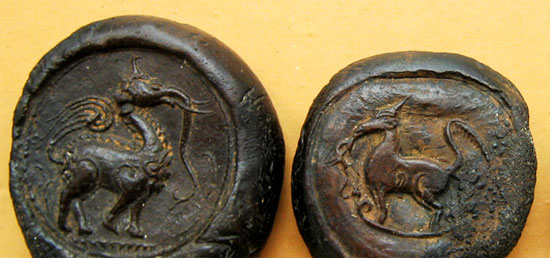Discovering Cham cultural artifacts in Quy Hop
Some people believe that these antiques are the ancient coins of the Cham Pa.
On a trip to the remote area of Chau Thai commune (Quy Hop district, Nghe An province), we were unknowingly received by Mr. Vi Van variable (85 years old, Thai ethnic people, Ban Co village, Chau Thai commune, Quy district). Hop, Nghe An province, showed the very strange artifacts that he kept quite well in his house for nearly a hundred years.
According to Mr. variable, those are the things that his father left behind, and told him to keep, not to give anyone, not to sell, to be considered "blessed" by the house, without it "the house will be full. disaster and unhappiness'.

Mr. Vi Van Transformers is showing off his ancient artifacts to guests
After carefully reviewing and understanding, although it is still very limited, we were extremely shocked because it was suddenly discovered that these are ancient Cham culture artifacts! The antiques are oval in shape, the diameter is 5 - 7cm, the thickness is about 1.5 - 2cm, the weight is quite light compared to the size.
Crafting material is a mixture of lac resin, beeswax and some other compounds with shiny black color, quite durable, light, hard to burn and waterproof.
The two sides of the antiquities are engraved with different figures, from Cham towers (in the form of Thap Mo in Binh Dinh, 12-14th century), to the symbolic form of Sanskrit . and especially image of GaJasimha god (elephant head, horse), this is a strong and unparalleled amphibious mascot, combining the power of a lion (the reincarnation of Vishnu) and the horse of Indra god - a rather universal type. turn in Cham sculpture art!

Statue of elephant head mascot, horse
Nghe An is a province with a long distance from the old Champa country (only from Binh Dinh onwards), so the factors related to 'Cham Pa - Oc Eo' culture are very modest.
In Nghe An the antiques of Cham Pa culture are rare, but still exist. The Cham sculptures often bear religious meaning, carved according to the Indian myths. Visual art is about legendary animals, in which the elephant is a very popular image.
The mascot icon called Ganesa has the art of shaping his head. Ganesa is a popular worshiped Hindu god. According to an anecdote, Ganesa was the deity of the god Silva, created by the god Silva from the flame of god on his forehead.
Ganesa was created by Silva's wife, because of the incident, the head fell, and was given an elephant head by Vishnu, so he was shown an elephant. God is the embodiment of the wisdom and wisdom of Lord Silva.
People consider Ganesa to be a good god, giving many good things, so besides the Cham, this god is also worshiped by many people in Asian countries such as Giava, Tibet and India .

GaJasimha image (elephant head, horse)
The figure of the mascot that we discovered at Mr. Vi Van Transformers's house in Co village, Quy Hop district (Nghe An) is called Gajasimha, the art of shaping is the elephant's head with a lion (or his horse): Here is an unequaled powerful amphibian, combining the power of a lion or a war horse (incarnation of Vishnu) and an elephant of Indra.
In Cham sculpture, this type is quite popular. These Gajasimha mascot figures bear the style of the Dark Tower of Binh Dinh in the 12-14 century.

Characters in Sanskrit form

Image of Cham tower
It is known that in the land of Vietnam today, in ancient times, there existed three countries: In general, the North is the territory of Dai Viet (typically Dong Son culture), the Central is the locality. of the kingdom of Cham Pa (typically Cham Pa culture) and the South is part of the territory of the Funan kingdom (characterized by Oc Eo cultural culture).
At that time, the area, the border, the borders between ancient nations were always obvious issues.
The kingdom of Cham Pa (Champapura / Nagara Champa), also known as Chiem Thanh, was an independent nation, which existed from around the 6th century (after the sun) on the land of present-day central Vietnam.
Cham Pa culture influenced by Chinese, Cambodian and Indian culture, has flourished with the peaks of Dong Duong style (9th-10th century) and My Son A1 style (10th century). - 11) that many monuments and towers and stone sculptures, linga artifacts . still exist today, showing the influence of Hinduism and Buddhism are the two main religions of the master. the ancient kingdom of Champa. In 1471, Cham Pa was annexed by Nguyen lords and merged into Vietnam!
- Cham treasures to America on display
- Discovering Cham thousand-year-old relic in Da Nang
- Discovering strange artifacts at My Son Sanctuary
- Discovered a thousand-year-old Cham temple complex
- Cham Pa antiques first appeared after more than 71 years
- Discovering 1,000-year-old Cham Pa ruins
- The largest ancient Cham tower was discovered
- Binh Thuan discovered relics of ancient Cham people
- Discovering many valuable archeological artifacts at the ancient Vietnamese 'city'
- Discover ancient wells that have never run out of water
- Detecting stone blocks of Cham Pa antiquities when constructing bridge foundation
- Phong Le artifacts are more than 1,000 years old
 Discovered an ancient centipede fossil 99 million years old
Discovered an ancient centipede fossil 99 million years old Discovered bat-like dinosaurs in China
Discovered bat-like dinosaurs in China Discovered a 200-year-old bronze cannon of the coast
Discovered a 200-year-old bronze cannon of the coast Discover 305 million-year-old spider fossils
Discover 305 million-year-old spider fossils